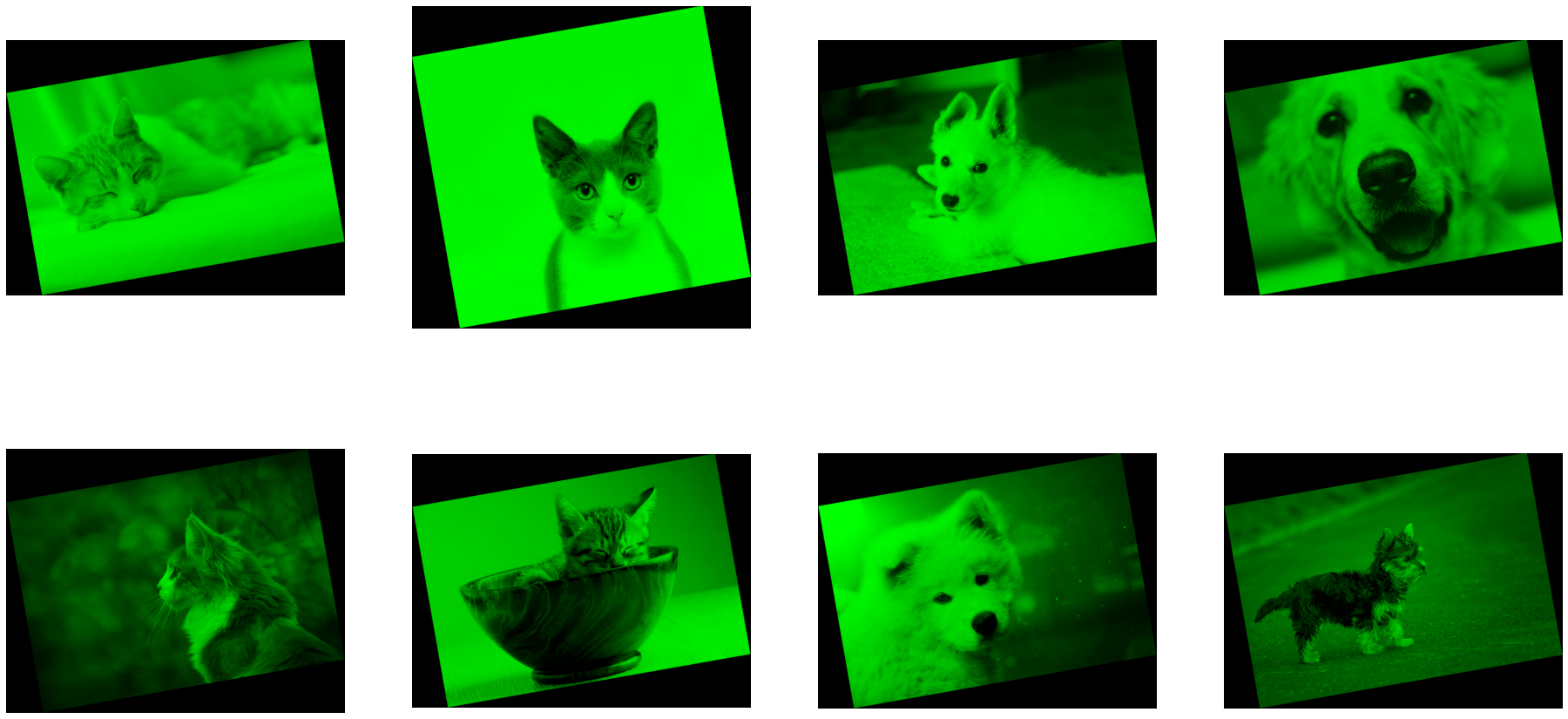Pipeline Debug Mode (experimental)#
Overview#
Debug mode is currently an experimental feature.
When you use DALI pipeline, you have to define the graph of operations ahead of time. In each iteration, the graph of operators is executed in the backend - and the user does not have access to the intermediate state, only to the pipeline outputs. This allows for better performance, but makes it harder to experiment and debug the pipeline (for more information on DALI’s execution process go to the Documentation). Debug mode allows you to access data as it’s being processed
in the graph. In standard DALI mode operators outputs are symbolic (DataNode). In debug mode those become DataNodeDebug that contain the underlying data.
Notice#
Debug mode is not meant to be fast, in this mode performance of your pipeline will be far worse, use it only for experimenting.
Seed generation in debug mode works differently than in standard mode (it is deterministic but different). If you want to achieve the same results in debug mode as in standard mode initialize operators with the
seedparameter.Direct calls to operators work only in a scope of the
pipeline_deffunction, you cannot use them this way outside ofpipeline_def.
Defining debug pipeline#
Since debug mode is still in development and its functionalities might change it is accessible from the experimental version of pipeline_def which works the same as the standard version but allows you to debug. To use debug mode:
Change the standard version of
nvidia.dali.pipeline_defto its experimental equivalentnvidia.dali.pipeline.experimental.pipeline_defDefine pipeline with parameter
debug=True
Let’s take a simple pipeline that reads images and rotates them and try out the debug mode on it.
[1]:
import nvidia.dali.fn as fn
from nvidia.dali.pipeline.experimental import pipeline_def
image_dir = "../data/images"
max_batch_size = 8
@pipeline_def(batch_size=max_batch_size, num_threads=1, device_id=0, debug=True)
def simple_pipeline():
jpegs, labels = fn.readers.file(
file_root=image_dir, random_shuffle=True, initial_fill=21
)
images = fn.decoders.image(jpegs, device="cpu")
rotated_images = fn.rotate(images, angle=10.0, fill_value=0)
return rotated_images, labels
The basic use of debug mode is to print objects returned by operators. It gives you much of the information you might want to check.
[2]:
@pipeline_def(batch_size=max_batch_size, num_threads=1, device_id=0)
def simple_pipeline_with_print():
jpegs, labels = fn.readers.file(file_root=image_dir, random_shuffle=True)
images = fn.decoders.image(jpegs, device="cpu")
print(images)
rotated_images = fn.rotate(images, angle=10.0, fill_value=0)
return rotated_images, labels
pipe = simple_pipeline_with_print(debug=True)
pipe.build()
pipe_out = pipe.run()
DataNodeDebug(
name="__Image_2",
data=TensorListCPU(
[[[[ 1 0 0]
[ 1 0 0]
...
[ 6 0 0]
[ 6 0 0]]
[[ 1 0 0]
[ 1 0 0]
...
[ 6 0 0]
[ 6 0 0]]
...
[[74 48 35]
[71 45 32]
...
[18 8 7]
[11 1 0]]
[[72 46 33]
[67 41 28]
...
[18 8 7]
[12 2 1]]]
[[[1 1 1]
[1 1 1]
...
[0 0 0]
[0 0 0]]
[[1 1 1]
[1 1 1]
...
[0 0 0]
[0 0 0]]
...
[[4 2 3]
[4 2 3]
...
[1 1 1]
[1 1 1]]
[[4 2 3]
[4 2 3]
...
[1 1 1]
[1 1 1]]]
...
[[[255 255 255]
[255 255 255]
...
[ 86 46 55]
[ 86 46 55]]
[[255 255 255]
[255 255 255]
...
[ 86 46 55]
[ 86 46 55]]
...
[[158 145 154]
[158 147 155]
...
[ 93 38 41]
[ 93 38 41]]
[[157 145 155]
[158 146 156]
...
[ 93 38 41]
[ 93 38 41]]]
[[[178 190 202]
[178 190 202]
...
[ 77 87 97]
[ 76 86 96]]
[[178 190 202]
[178 190 202]
...
[ 77 87 97]
[ 77 87 97]]
...
[[192 192 192]
[188 188 188]
...
[231 228 221]
[234 231 224]]
[[188 188 188]
[195 195 195]
...
[224 221 214]
[234 231 224]]]],
dtype=DALIDataType.UINT8,
layout="HWC",
num_samples=8,
shape=[(669, 640, 3),
(427, 640, 3),
(480, 640, 3),
(427, 640, 3),
(427, 640, 3),
(409, 640, 3),
(427, 640, 3),
(425, 640, 3)]))
Using it this way allows you to easily swap between standard and debug mode.
[3]:
pipe_standard = simple_pipeline_with_print()
pipe_standard.build()
pipe_out = pipe_standard.run()
DataNode(name="__Image_6", device="cpu")
In debug mode each time you call run the code of your pipeline is executed (that way you can access the state of your pipeline in every iteration) as opposed to the standard mode where the code defining your pipeline is executed only once when you call build.
Notice how we get different prints every time we call run. Also you can use it on GPU just like a standard DALI pipeline.
[4]:
@pipeline_def(batch_size=max_batch_size, num_threads=1, device_id=0)
def simple_pipeline_with_print():
jpegs, labels = fn.readers.file(file_root=image_dir, random_shuffle=True)
images = fn.decoders.image(jpegs, device="mixed")
print(jpegs)
rotated_images = fn.rotate(images, angle=10.0, fill_value=0)
return rotated_images, labels
pipe = simple_pipeline_with_print(debug=True)
pipe.build()
for _ in range(5):
pipe.run()
DataNodeDebug(
name="__File_8[0]",
data=TensorListCPU(
[[255 216 ... 255 217]
[255 216 ... 255 217]
...
[255 216 ... 255 217]
[255 216 ... 255 217]],
dtype=DALIDataType.UINT8,
num_samples=8,
shape=[(35731,),
(24253,),
(30716,),
(40177,),
(23894,),
(25958,),
(91537,),
(24441,)]))
DataNodeDebug(
name="__File_8[0]",
data=TensorListCPU(
[[255 216 ... 255 217]
[255 216 ... 255 217]
...
[255 216 ... 255 217]
[255 216 ... 255 217]],
dtype=DALIDataType.UINT8,
num_samples=8,
shape=[(20069,),
(35646,),
(33781,),
(50295,),
(29762,),
(35941,),
(25486,),
(41063,)]))
DataNodeDebug(
name="__File_8[0]",
data=TensorListCPU(
[[255 216 ... 255 217]
[255 216 ... 255 217]
...
[255 216 ... 255 217]
[255 216 ... 255 217]],
dtype=DALIDataType.UINT8,
num_samples=8,
shape=[(34115,),
(20716,),
(23382,),
(39469,),
(26287,),
(39469,),
(35646,),
(26287,)]))
DataNodeDebug(
name="__File_8[0]",
data=TensorListCPU(
[[255 216 ... 255 217]
[255 216 ... 255 217]
...
[255 216 ... 255 217]
[255 216 ... 255 217]],
dtype=DALIDataType.UINT8,
num_samples=8,
shape=[(23382,),
(24253,),
(91537,),
(50295,),
(35941,),
(30716,),
(24441,),
(25958,)]))
DataNodeDebug(
name="__File_8[0]",
data=TensorListCPU(
[[255 216 ... 255 217]
[255 216 ... 255 217]
...
[255 216 ... 255 217]
[255 216 ... 255 217]],
dtype=DALIDataType.UINT8,
num_samples=8,
shape=[(41063,),
(20716,),
(33781,),
(20069,),
(23894,),
(35731,),
(25486,),
(29762,)]))
While in standard mode the print is executed only once (when calling build) and run schedules execution of already defined graph in the backend.
[5]:
pipe = simple_pipeline_with_print(debug=False)
pipe.build()
for _ in range(5):
pipe.run()
DataNode(name="__File_13[0]", device="cpu")
Additional features#
Debug mode provides some additional features for data manipulation. For example we can visualize the data that is produced as intermediate step in the pipeline.
First, let’s define a helper function that can be used to show a batch of images.
[6]:
import matplotlib.gridspec as gridspec
import matplotlib.pyplot as plt
%matplotlib inline
def show_images(image_batch):
columns = 4
rows = (max_batch_size + 1) // (columns)
plt.figure(figsize=(32, (32 // columns) * rows))
gs = gridspec.GridSpec(rows, columns)
for j in range(rows * columns):
plt.subplot(gs[j])
plt.axis("off")
plt.imshow(image_batch.at(j))
Data access#
By calling .get() on a DataNodeDebug returned by an operator, you can access the underlying TensorList directly, which is not possible with a standard DataNode.
[7]:
@pipeline_def(batch_size=8, num_threads=1, device_id=0, debug=True)
def simple_pipeline_with_show():
jpegs, labels = fn.readers.file(file_root=image_dir, random_shuffle=True)
images = fn.decoders.image(jpegs, device="cpu")
show_images(images.get())
rotated_images = fn.rotate(images, angle=10.0, fill_value=0)
return rotated_images, labels
pipe = simple_pipeline_with_show(debug=True)
pipe.build()
pipe_out = pipe.run()

You can check shape of the data.
[8]:
iter = 0
@pipeline_def(batch_size=8, num_threads=1, device_id=0, debug=True)
def simple_pipeline_with_shape():
jpegs, labels = fn.readers.file(file_root=image_dir, random_shuffle=True)
images = fn.decoders.image(jpegs, device="cpu")
print(f"Iteration {iter}, shapes={images.shape()}")
rotated_images = fn.rotate(images, angle=10.0, fill_value=0)
return rotated_images, labels
pipe = simple_pipeline_with_shape(debug=True)
pipe.build()
for _ in range(5):
pipe_out = pipe.run()
iter += 1
Iteration 0, shapes=[(427, 640, 3), (427, 640, 3), (427, 640, 3), (427, 640, 3), (480, 640, 3), (597, 640, 3), (425, 640, 3), (427, 640, 3)]
Iteration 1, shapes=[(427, 640, 3), (427, 640, 3), (485, 640, 3), (480, 640, 3), (446, 640, 3), (409, 640, 3), (427, 640, 3), (480, 640, 3)]
Iteration 2, shapes=[(669, 640, 3), (480, 640, 3), (425, 640, 3), (425, 640, 3), (427, 640, 3), (425, 640, 3), (485, 640, 3), (427, 640, 3)]
Iteration 3, shapes=[(427, 640, 3), (427, 640, 3), (480, 640, 3), (427, 640, 3), (446, 640, 3), (480, 640, 3), (427, 640, 3), (669, 640, 3)]
Iteration 4, shapes=[(480, 640, 3), (597, 640, 3), (409, 640, 3), (480, 640, 3), (427, 640, 3), (425, 640, 3), (427, 640, 3), (425, 640, 3)]
Data modification#
You can modify the data (e.g. by casting it to a NumPy ndarray or a PyTorch tensor) and then pass it directly to the operator. Operators in debug mode accept same sources as External Source Operator.
[9]:
import numpy as np
@pipeline_def(batch_size=8, num_threads=1, device_id=0, debug=True)
def simple_pipeline_with_modification():
jpegs, labels = fn.readers.file(file_root=image_dir, random_shuffle=True)
images = fn.decoders.image(jpegs, device="cpu")
images = [np.array(tensor) for tensor in images.get()]
for image in images:
image[:, :, [0, 2]] = 0
rotated_images = fn.rotate(images, angle=10.0, fill_value=0)
show_images(rotated_images.get())
return rotated_images, labels
pipe = simple_pipeline_with_modification(debug=True)
pipe.build()
pipe_out = pipe.run()

Warning#
As debug mode is meant to imitate execution of standard mode as closely as possible you cannot change the order of operators. For example, this is not allowed:
[10]:
iter = 0
@pipeline_def(batch_size=8, num_threads=1, device_id=0, debug=True)
def corrupted_pipeline():
jpegs, labels = fn.readers.file(file_root=image_dir, random_shuffle=True)
images = fn.decoders.image(jpegs, device="cpu")
if iter == 1:
images = fn.crop(images, crop=[256, 256])
rotated_images = fn.rotate(images, angle=10.0, fill_value=0)
show_images(rotated_images.get())
return rotated_images, labels
pipe = corrupted_pipeline(debug=True)
pipe.build()
for _ in range(2):
try:
pipe_out = pipe.run()
except RuntimeError as err:
print(f"Error: {err}")
iter += 1
Error: Unexpected operator 'crop'. Debug mode does not support changing the order of operators executed within the pipeline.
